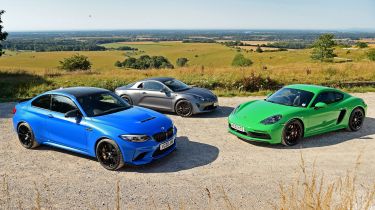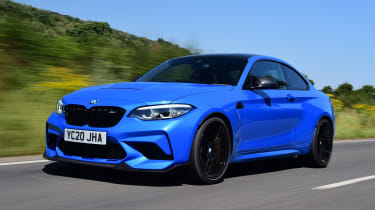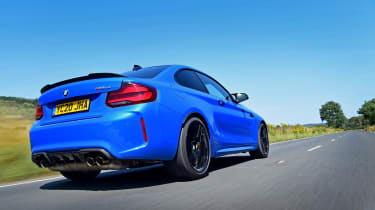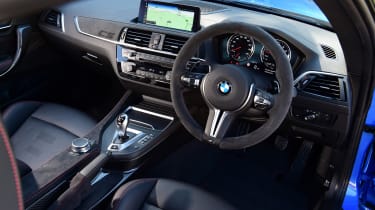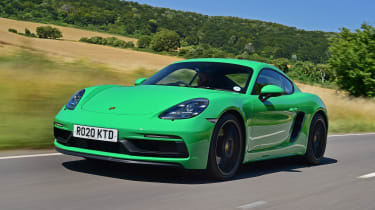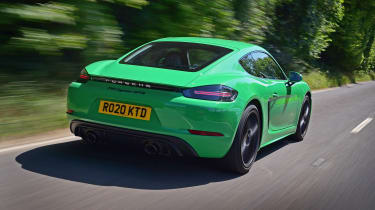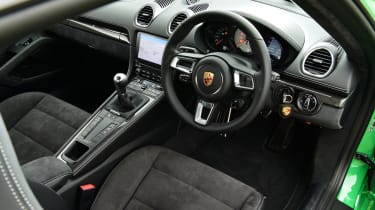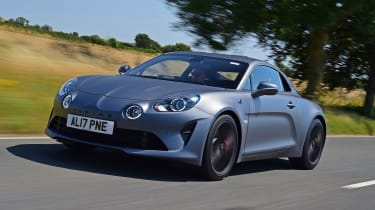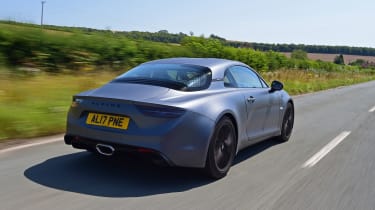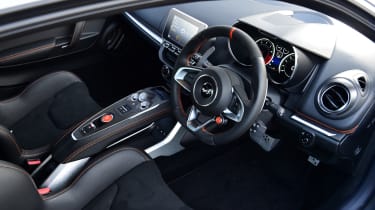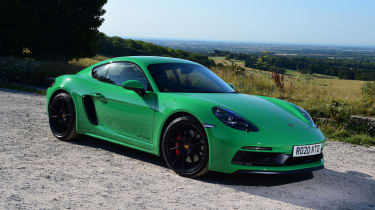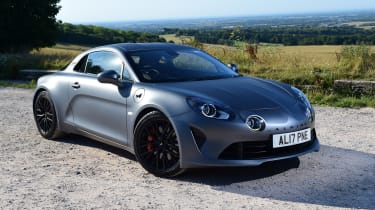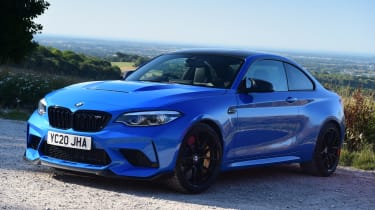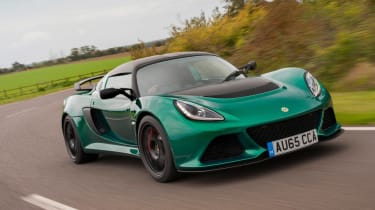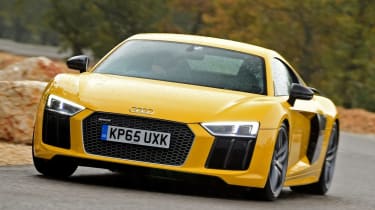BMW M2 CS vs Porsche 718 Cayman GTS vs Alpine A110 S
The new BMW M2 CS is the most hardcore M2 yet, but is it a match for the Porsche 718 Cayman GTS and Alpine A110 S?
Evolution is a complex process, but all three of the sports cars here exhibit classic character traits of time improving the species.
The newest model of our trio is the BMW M2 CS. The M2 was launched in 2016, before Competition spec upped the ante. Now, in CS form, it’s evolved even further, with more power, more lightweight components and a more hardcore chassis.
It’s the most compact, most driver-focused M car, and it just so happens Porsche has recently revised its 718 Cayman to place even more emphasis on fun and involvement with its new GTS 4.0.
This pair of German machines offer two different approaches to driving enjoyment, and ramping up its standard A110 last year, Alpine’s A110 S offers yet another path to follow. Thanks to its lightweight construction the French model doesn’t need huge amounts of power like the M2 CS, but it’s on-paper performance and what it promises to deliver look as appealing as BMW’s latest offering.
There’s quite a price gap between the most affordable and the most expensive model in this test, and while monthly payments might make this more manageable, performance enthusiasts value exactly that commodity. Therefore, while cost is still a factor, it might not be quite as important as how these cars make you feel and what they offer on the right road, so let’s find out which hits hardest here.
BMW M2 CS
| Model: | BMW M2 CS DCT |
| Price: | £77,455 |
| Engine: | 3.0-litre 6cyl inline turbo, 444bhp |
| 0-62mph: | 4.0 seconds |
| Test economy: | 26.0mpg/5.7mpl |
| CO2: | 223g/km |
| Annual road tax: | £475 |
The M2 CS is a super-focused sports car with power, aggressive looks and a surprising level of usability, too. Is this enough for it to overcome the challenge from its talented rivals, though?
Used - available now

2022 Mercedes
EQA
21,343 milesAutomaticElectric
Cash £23,800
2022 Mercedes
CLA
88,049 milesAutomaticPetrol1.3L
Cash £19,300
2024 BMW
M135i
29,519 milesAutomaticPetrol2.0L
Cash £24,487
2022 Audi
A4
37,569 milesManualPetrol2.0L
Cash £15,887Design & engineering
The enhancements to the M2 CS over its lesser siblings are considerable. The body is based on BMW’s soon-to-be-replaced 2 Series Coupé, as with the normal M2 Competition model. However, compared with that car, the CS features a big power boost.
Its twin-turbocharged 3.0-litre straight-six engine now makes 444bhp and 550Nm of torque, and is derived from the motor fitted to the M4 Competition. Here, it sends drive to the rear axle through a seven-speed dual-clutch transmission, although a six-speed manual is also available. On that rear axle there’s an active electronically controlled limited-slip differential to help boost agility and traction.
There are plenty of lightweight carbon-fibre components to help keep the weight down to 1,625kg, although the CS is still the heaviest car here. The bonnet and roof are made from carbon fibre, while there’s a strut brace under the bonnet made from the same material to increase chassis stiffness.
The body looks more menacing than any M2 yet. Its boxy wheelarches are huge and give the CS a real muscle-bound stance; they allow fitment of 19-inch forged alloys, shod in Michelin Cup 2 tyres. There’s also a new front splitter, rear Gurney flap and a fresh diffuser to optimise the aerodynamics.
Plenty of aluminium components are used in the front MacPherson strut and rear multi-link suspension, while the rear axle subframe is bolted directly to the body to help driver feedback.
The suspension is controlled by adaptive dampers as standard, plus you get M Sport brakes. These can be upgraded to carbon-ceramic items for £6,250.
Inside, the makeover isn’t quite as extensive, but racier touches include an Alcantara steering wheel, leather sports seats and lots of CS badging to remind you this is the most special of M2 models.
Driving
The CS feels brawny. Despite the car’s slightly porky kerbweight for a small coupé, the engine has masses of mid-range grunt, but it’s so fast here that you tend to use the torque more, rather than revving it out.
It does pull well higher up the rev range and, in this DCT-equipped car with launch control, the 0-62mph sprint takes 4.0 seconds, making it the quickest car here, but it doesn’t have the rush to its rev limiter like the Cayman’s engine does. On the road, it becomes natural to rely on the punch and flexibility turbocharging brings, while the huge, sticky rear tyres mean there’s plenty of traction, too.
The balance is nice; the CS feels adjustable on the throttle and small enough that you can play with it on the road, but it also feels a little unruly at times in how its chassis behaves.
In Comfort mode the body control is on the loose side, so the car bounces up and down on bumpy roads. Step it up through Sport and Sport Plus and, while this tautens up the vertical movement, the dampers then feel firm in the top setting, and the big wheels crash over cats’ eyes. Compared with its test rivals, the CS feels more disjointed and less flowing.
It’s compounded by the steering, because there’s not much feel or delicacy to what information is relayed to the driver. There’s weight and solidity, and you can step this up with the different modes, but the sportiest setting feels over-egged and too heavy, even if it is in keeping with the CS’s muscle-bound character. Sport is sweetest. There’s no doubt it’s fun and the CS has a clearly-defined personality, but there are a few flaws that you have to live with.
Practicality
One area where the CS beats its rivals is practicality, but maybe not how you think. The 390-litre boot is plenty for a car of this size, beating some family hatchbacks, but it’s the two rear seats that give it extra flexibility over the GTS and A110 S. They’ll be better for children, but adults will still be fine back there for short trips.
The M2’s cabin is starting to look a little old, yet so is the Cayman’s. Instead, while quality is good, it’s the fact that the CS is based on the 2 Series body that helps usability, because visibility is surprisingly good, especially compared with the much lower, sleeker-looking Alpine. You get front and rear parking sensors as standard on the BMW, while a reversing camera is a £330 extra.
Ownership
The ownership prospect here might be more affected by how much it costs to replace tyres and brakes (given these cars will be bought by enthusiasts who might take them on circuit), rather than by the maker’s position in our Driver Power survey. Yet BMW was the only brand of these three to rank, and finished poorly in 27th place.
Those Michelin Cup 2 tyres provide lots of grip, but are pricey to replace, at £288 for fitting a rear tyre.
Running costs
With lots of power but turbos to help efficiency, the M2’s test economy was respectable. When cruising off the turbo’s boost you use less fuel, so a result of 26.0mpg on test means fuel bills of £2,388 a year at today’s prices.
The whole point of a move towards turbocharged four-cylinder engines for Porsche was to boost efficiency, but a result of 27.7mpg here and an annual fuel bill of £2,241 shows it’s not necessary – remember, it’s 220kg lighter than the BMW.
But the Alpine shows how important weight can be to efficiency. It returned 30.8mpg for an annual fuel bill of £2,016. Again, as long as all three cars’ running costs are within a certain window, a buying decision with machines like this might be ruled more by heart than head for many buyers.
Testers’ notes
“The M2’s active differential is great. You can tap into the rear-drive balance easily with all that torque, but through quicker corners it helps the CS feel planted and stable.”
Porsche 718 Cayman GTS
| Model: | Porsche 718 Cayman GTS 4.0 |
| Price: | £65,993 |
| Engine: | 4.0-litre flat six, 395bhp |
| 0-62mph: | 4.5 seconds |
| Test economy: | 27.7mpg/6.1mpl |
| CO2: | 247g/km |
| Annual road tax: | £475 |
Porsche’s 718 Cayman GTS returns with a new naturally aspirated engine, but is it a better driver’s car than the BMW M2 CS?
Design & engineering
When Porsche launched its revised 718 Cayman, some enthusiasts were disappointed with the choice of a turbocharged flat-four engine in place of the old naturally aspirated flat six. Even the GTS featured a beefed-up 2.5-litre four-cylinder unit.
But following the hardcore range-topping 718 Cayman GT4, which used a non-turbo flat-six motor once again, the big news for this GTS 4.0 model is that a more regular production 718 Cayman now uses an engine layout Porsche is famous for. It’s a detuned version of the 4.0-litre flat-six motor in the GT4, producing 395bhp and 420Nm of torque.
While those figures are some way down on the BMW’s output, remember that the GTS 4.0 shuns turbocharging in the pursuit of driver involvement, sound, response and other factors enthusiasts love. That’s why the only gearbox option currently available is a six-speed manual, too.
It’s also worth pointing out that the GTS 4.0 is 220kg lighter than the M2 CS, at 1,405kg, which will go some way to offsetting the power and torque deficit. Otherwise, there is a similar focus to the drivetrain and chassis, with power being sent to the rear wheels only through a mechanically locking differential with Porsche Torque Vectoring.
Adaptive damping for the multi-link front and rear suspension is standard, and the ride height is lowered by 20mm compared with lesser Caymans; there are dynamic gearbox mounts, plus 20-inch alloy wheels, and a sports braking system with six-piston calipers at the front. As with the M2 CS, you can upgrade these to carbon-ceramic items for £5,177. A sports exhaust system is fitted as standard.
But despite the £11,462 price saving over the M2 CS (£9,362 compared with the manual CS) the Porsche lacks a lot of the BMW’s kit, so you’ll have to option it up with extras including, but not limited to, LED lights (£1,397), front and rear parking sensors (£623), cruise control (£228), keyless operation (£497), an ISOFIX point (£126) and dual-zone climate control (£539) to match the CS’s spec. Our test car came in at £74,343.
Driving
It’s amazing how much a change of engine can alter the character of a car. The 718 GTS’s chassis is as good as it ever was, but now that it has naturally aspirated flat- six power it feels so much purer, like the sports car we always hoped the GTS would be.
The 4.0-litre unit’s throttle response is razor sharp and despite the long gearing it still feels like there’s more than enough torque for easy overtakes, even if the M2 outguns it in the mid-range – and over the 0-62mph sprint by half a second. Although that’s not bad given the GTS 4.0 is manual-only at the minute.
This Cayman is less about the raw numbers and more about the subjective elements it offers anyway. The engine loves to be worked hard; its power delivery is beautifully linear and the accompanying soundtrack means you’ll keep pushing it, every successive 1,000rpm revealing a new bark and rasp from the exhaust. It’s far from a one-trick pony, though; the chassis is as beautifully balanced, reassuringly composed in its responses to bumps, and the steering as detailed as pretty much any electrically assisted set-up on sale today. The weight and speed perfectly match the chassis’ agility and the grip on offer.
The dampers deftly soak up imperfections without the harshness of the M2. Body control is better, too, so it’s more comfortable more of the time, yet even more capable. The final masterstroke is the GTS’s six-speed gearbox. When manuals are this good and the shift this involving, it’s worth savouring. The engine and box are matched perfectly.
Practicality
You might think the mid-engined Cayman is less practical than the front-engined M2, but despite the CS’s relatively usable 390-litre boot, the Porsche actually offers more luggage space, at 420 litres. This is split between a 150-litre load area at the front that’s a uniform shape, and a 270-litre rear compartment, packaged around the engine. This space is a little more compromised in its shape, but towards the rear of the car it’s deep and wide enough for overnight bags.
You don’t get the rear seats of the BMW because, like the Alpine, the Porsche is a two-seater. Storage isn’t as good as in the M2, either. There are fewer trays and the door bins aren’t as easy to access, but this is a minor point in a trio that are all about driving.
Ownership
These cars do need to be usable every day, though, and safety equipment could therefore be important. Most of the Porsche’s protective kit is optional, including blind- spot assist (£413). There’s no adaptive cruise or AEB. Even parking sensors and a rear-view camera are optional, but they could be useful given rear visibility is a little more limited than in the BMW. It’s still significantly better than the Alpine, though.
Running costs
One of the GTS’s original-equipment rear tyres costs £244 fitted, but these aren’t quite as hardcore as those on the CS.
The Porsche image seems to carry the most weight out of these three brands, according to our experts; the GTS is expected to retain 63.5 per cent of its list price after three years/36,000 miles. It means a residual value of £41,925 for cash buyers, compared with £46,326 for the M2 CS (59.8 per cent).
The Alpine just edges the BMW and although its predicted £34,547 RV is much lower than the other two, it’s much cheaper, so the percentage rating of 60.5 per cent is very strong. Bear in mind these predicted RVs have an impact on finance deals.
Testers’ notes
“You might have guessed, but the engine defines this car. It’s so much sweeter than the 2.5-litre flat-four turbocharged GTS model from a few years ago, not least because of the wonderful noise it makes.”
Alpine A110
| Model: | Alpine A110 S |
| Price: | £57,140 |
| Engine: | 1.8-litre 4cyl turbo, 288bhp |
| 0-62mph: | 4.4 seconds |
| Test economy: | 30.8mpg/6.8mpl |
| CO2: | 163g/km |
| Annual road tax: | £475 |
Alpine’s reborn A110 has been a massive hit. It’s our reigning coupé champion, taking the title last year at our New Car Awards, and it’s back here in upgraded A110 S form, priced from £57,140.
Design & engineering
Despite engine tweaks upping the 1.8-litre four-cylinder turbocharged unit’s power and torque outputs to 288bhp and 320Nm respectively, the core of the A110 S is the same as the standard car. That means low weight is key, and the bespoke aluminium chassis and aluminium components for the all-round double wishbone suspension help keep this figure down to 1,114kg. That’s a massive 511kg lighter than the BMW, which means that although the Alpine gives away 156bhp and 230Nm of torque to the M2 CS, its claimed performance isn’t too far behind.
This isn’t a machine focused on straight-line shove anyway, it’s all about handling. From the ground up the S wears wider tyres wrapped in a new compound of rubber compared with the standard A110, the ride height has been reduced by 4mm, and the suspension’s springs are a whopping 50 per cent stiffer, with the damping rates retuned accordingly. The hollow anti-roll bars are 100 per cent stiffer.
Alpine’s intentions of making the S a more focused version of the A110 are obvious. There’s an optional carbon-fibre roof to further lower the centre of gravity, even if its aesthetic benefit might be more noticeable than its engineering contribution (it’s only a 1.9kg saving, but it all helps), while forged Fuchs alloys hide Brembo four-piston front brake calipers.
Some more orange detailing, a few chequered flag logos and our car’s matte grey paint are all bespoke to the A110 S, too, but despite topping the range there are fewer options available. There’s a level of core kit to broadly match the M2 as well (see our Through the range panel on the next page to see what’s standard), while quality is sound. The Sabelt sports seats are nice, but there are more hard materials and surfaces than in the BMW or Porsche – it’s obvious this is the most pared-back machine here.
Driving
As soon as you drive the A110 S you notice its extra focus compared with the standard car. But in comparison with its rivals it still has the wonderfully rewarding flowing ride quality and supple sensation in the way its suspension works. That can only come from the car’s low weight, which has a massive impact on every area dynamically.
The steering is also light, but you can feel the level of adjustability and the pointiness Alpine has engineered into the chassis and coaxed from the platform with the tweaks to the A110 for this S.
It offers something neither the M2 nor Cayman can. It feels devoid of excess mass and therefore so agile and willing to respond to your inputs, with seemingly little delay between you making them and the car reacting, even if the sensations that make it feel alive also mean it feels a little less tied down.
Despite its relatively humdrum engine compared with its competitors’, that lack of mass shows its benefits again as the dual-clutch-only Alpine takes just 4.4 seconds to sprint from 0-62mph. The motor gargles away behind you but picks up strongly and revs with verve for a turbo at higher revs. The dual-clutch gearbox’s upshifts are fast enough, but it feels more laboured going down the ratios; the CS’s transmission isn’t perfect either, jerking changes under full throttle sometimes. Both are fine if left to their own devices.
Practicality
The A110 S is the most compact car here. It’s so low that the seat is reclined to not otherwise compromise forward visibility, but this means that while the seat does offer support, the driving position isn’t the most comfortable. The BMW’s driving position is a little too high, but the Porsche’s is perfect, with the widest range of adjustment for the seat and wheel.
Housing its engine in the middle and fuel tank at the front compromises the Alpine’s luggage space, even when compared with the mid-engined GTS, although the Porsche is a physically larger car. There is a total of 96 litres under the A110’s low nose – it’s a shallow, square-shaped tray – with 100 litres under a small boot flap in the tail. The space is usable and will take two squashy bags, it’s just that the opening is small. There’s some room behind the seats, too.
Visibility is much more restricted in the Alpine, as is storage, so the front and rear parking sensors really do come in handy. A rear camera costs £480.
Ownership
Alpine didn’t rank in our Driver Power 2020 poll, but it’s owned by Renault and uses a similar engine to that in the Mégane R.S. 300 Trophy, which we know is a punchy, reliable unit. Renault finished 15th out of 30 brands this year.
The A110 S has autonomous braking and four airbags as standard, but no option to add tech such as blind-spot monitoring or lane-keep assist. The aluminium structure is strong and stiff, though, so the safety cell offers lots of protection, like its rivals.
Running costs
The lightweight Alpine is by far the cheapest machine to run for business users. With CO2 emissions of 163g/km, it’ll cost a higher-rate taxpayer £7,957 a year.
Despite offering the most power and weighing the most, the CS’s turbocharged engine and DCT gearbox do at least mean a respectable 223g/km. This is the most expensive car here, so it’ll still cost the same company car driver £1,328 more a year to run than the GTS, at £10,871 in total.
However, few people are likely to use these cars as business vehicles, so fuel economy, servicing and insurance could be more important. As a comparison with its rivals, a new Michelin Pilot Sport 4S rear tyre costs £133 fitted on the A110 S.
Testers’ notes
“There are fewer options – some people might say distractions – on the A110 S, but it’s all the better for it. I love the purity of the car’s chassis.”
Verdict
First place: Porsche 718 Cayman GTS
The non-turbo flat-six engine has elevated the 718 Cayman to greatness in GTS 4.0 form. Its cabin is showing its age, though, and while it is cheaper than the M2, you’ll have to add plenty of optional kit, which brings the price to not far from parity. However, now it has the motor to match its brilliant gearbox and stunningly capable chassis, it’s one of the most convincing sports cars on sale at any price.
Second place: Alpine A110 S
In S form the A110 just edges the M2 and amplifies what makes the standard car great, without sacrificing the delicacy we know and love. The engine is outclassed here, but the chassis’ ability is so good, and what it offers so different, that you have to applaud Alpine for committing to this path. Its steering, damping and agility are the stars of the show, but then they are in the cheaper regular model, too.
Third place: BMW M2 CS
The CS is a fitting sign-off for the M2. It feels aggressive and unyielding in some respects, but this character makes you drive it hard and to its strengths, of which there are many. It’s pricey and the interior is old (and not as special as it should be), but the CS offers huge performance and personality. It feels like an old-school sports car that’s dominated by its engine and firm but grippy chassis that buyers will love.
Also consider...
Lotus Exige
- New: Lotus Exige Sport 350
- Price: £62,300
- Engine: 3.5-litre V6, 345bhp
If you’re after a compact, driver-focused coupé then the Lotus Exige is one of the best. It’s more uncompromising than our test trio, but the V6 packs a punch and the lightweight chassis is superbly communicative. It’s still a great sports car.
Audi R8
- Used: Audi R8 V10
- Price: £75,000
- Engine: 5.2-litre V10, 533bhp
For the price of the CS, you could bag a proper used supercar. The lower-powered Audi R8 still offers 533bhp from its howling V10; it’s one of the best production engines made and sounds glorious, while the chassis’ ability backs this up, plus its image is a cut above.
Figures
| Porsche 718 Cayman GTS 4.0 | Alpine A110 S | BMW M2 CS | |
| On the road price/total as tested | £65,993/£74,343 | £57,140/£57,920 | £77,455/££84,035 |
| Residual value (after 3yrs/36,000) | £41,925/63.5% | £34,547/60.5% | £46,326/59.8% |
| Depreciation | £24,068 | £22,593 | £31,129 |
| Annual tax liability std/higher rate | £4,771/£9,543 | £3,978/£7,957 | £5,435/£10,871 |
| Annual fuel cost (12k/20k miles) | £2,241/£3,735 | £2,016/£3,359 | £2,388/£3,979 |
| Insurance group/quote/VED | 47/£883/£475 | 46/£805/£475 | 50/£1,110/£475 |
| Cost of 1st/2nd/3rd service | £495/£630/£495 (est.) | TBC | £45 per month (3yrs) |
| Length/wheelbase | 4,405/2,475mm | 4,180/2,420mm | 4,461/2,693mm |
| Height/width | 1,276/1,801mm | 1,248/1,798mm | 1,414/1,871mm |
| Engine | Flat-six/3,995cc | 4cyl in-line/1,798cc | 6cyl in-line/2,979cc |
| Peak power/revs | 395/7,000 bhp/rpm | 288/6,400 bhp/rpm | 444/6,250 bhp/rpm |
| Peak torque/revs | 420/5,000 Nm/rpm | 320/2,000 Nm/rpm | 550/2,350 Nm/rpm |
| Transmission | 6-speed man/rwd | 7-speed DCT/rwd | 7-speed DCT/rwd |
| Fuel tank capacity/spare wheel | 64 litres/repair kit | 45 litres/repair kit | 52 litres/repair kit |
| Boot capacity (seats up/down) | 150/270 litres | 96/100 litres | N/A/390 litres |
| Kerbweight/payload/towing weight | 1,405/295kg | 1,114/241kg | 1,625/460kg |
| Turning circle | 11.0 metres | 11.6 metres | 11.7 metres |
| Basic warranty/recovery | 3yrs (unlimited)/3yrs | 3yrs (60,000)/3yrs | 3yrs (unlimited)/3yrs |
| Driver Power manufacturer/dealer pos | N/A/N/A | N/A/N/A | 27th/25th |
| NCAP: Adult/child/ped./assist/stars | 4.5 secs/182mph | 4.4 secs/162mph | 4.0 secs/174mph |
| 0-62mph/top speed | 27.7/6.1/390 miles | 30.8/6.8/305 miles | 26.0/5.7/297 miles |
| Auto Express econ (mpg/mpl)/range | 25.9mpg | 38.7mpg | 28.5-29.1mpg |
| WLTP combined | 5.7mpl | 8.5mpl | 6.3-6.4mpl |
| WLTP combined | 236/247g/km/37% | 212/163g/km/35% | 251/223g/km/37% |
| Actual/claimed CO2/tax bracket | Six/£126 | Two/no | Six/yes |
| Airbags/Isofix/park sensors/camera | £362/£1,086* | F&R/£480 | F&R/£330 |
| Automatic gearbox/lane keep assist | No/no/£413/no | Yes/no/no/yes | Yes/yes/yes/yes |
| Blindspot detection/AEB | £539/£228 | Yes/yes | Yes/yes |
| Climate/cruise control | Yes/yes | Yes/no | Yes/yes |
| Keyless entry/power tailgate | £632/£1,397 | £780/yes | Yes/adaptive |
| Leather/heated seats | Yes/£5,177 | Yes/no | Yes/£6,250 |
| Metallic paint/LED headlights | Yes/no | Yes/yes | Yes/no |
| Sat-nav/digi dash/DAB/connectivity | Yes/yes | Yes/yes | Yes/yes |
| Wireless charge/CarPlay/Android Auto | No/yes/no | No/yes/yes | No/yes/no |
